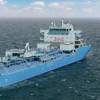Uncle Sam Unveils Two New Economic Incentives
Two significant new financial management tools were recently unveiled by the Federal government in one highly visible piece of legislation, and each can significantly change the way that you do business. Both have the promise to stimulate business growth while adding to a company’s bottom line. Each has both friends and foes in the commercial marine industry.
The Economic Stimulus Act of 2008 was signed into law on February 13, 2008. It provides, among other economic stimuli, the re-enactment of subsection (k) of Sec.168 and changes to subsection (b) of Sec.179 of the Internal Revenue Code of 1986. The former deals with bonus depreciation and the latter with elective expensing.
Accelerated Bonus Depreciation in 2008 (§168)
Those familiar with the GO-Zone post-9/11 stimulus bills will notice that this new stimulus act is very similar. It provides a bonus first year depreciation deduction of 50 percent of the adjusted basis of new equipment including computers, office furniture, cranes, forklifts, etc., and, notably for this industry, vessels.
The bonus reduces the adjusted basis for the property before computing the regular tax depreciation and is additive to the modified accelerated cost recovery system (MACRS) depreciation you normally use to depreciate your new equipment. The types of property eligible for bonus depreciation are tangible property with a recovery period of 20 years or less; certain depreciable computer software; water utility property; and qualified leasehold improvement property.
The property must be acquired and placed in service after December 31, 2007 and before January 1, 2009. This “bonus” as its known is also available on costs incurred during 2008 for property placed in service before January 1, 2010, if the property has an estimated build time of one year or more and a cost of $1m or more. For alternative minimum tax (AMT) purposes, bonus depreciation is allowed.
Elective Small Business Expensing (§179)
In lieu of depreciation, small business taxpayers may immediately write-off (expense) the cost of qualifying property put in service in 2008 up to $250,000 (an increase from the current level of $128,000). The annual investment limit is increased from its current level of $510,000 to $800,000 for 2008. The amount of the deduction is limited to the amount of the business’ taxable income.
What is the impact of this on the commercial marine industry? According to the Equipment Leasing and Finance Association, business investment in plant and equipment accounts for between 15–17 percent of Gross Domestic Product (GDP). The U.S. Department of Commerce pegged the GDP at over $13.5 trillion in 2006 equating to nearly $2.16 trillion in business investment.
Reliable statistics are not available to quantify the dollar amount the commercial marine industry contributes to the GDP, but most think that it is about $35 billion. At 15 percent, the investment in marine equipment is at least $5.25 billion. Taking both the bonus and MACRS into account, we’re looking at nearly 55 percent depreciation on assets placed in service in 2008. The impact is huge and could be larger by the time updated GDP figures are released.
Government sources reported that after the passage of the Jobs Act of 2003, GDP growth in the third quarter spiked upwards at an annual rate of nearly 8 percent, while growth in the first two quarters of 2003 was only between 1-3 percent, returning to about 4 percent in Q4. If a similar trend is evidenced by growth in the third quarter of 2008, the economy may be booming by the end of summer.
A caveat here: although these stimuli are initially a windfall for businesses that can utilize them on their balance sheets, or can build or acquire new assets within the calendar year, the drawbacks are evident for such assets that are held for only a short period of time. Consult your accountant or financial adviser to determine the possible capital gains implications of the sale of an asset that has been depreciated under these accelerated conditions.
If you can’t use the depreciation or expensing, the stimulus package will not affect your business in the same way as those who can. However, you can still derive a significant indirect benefit if you choose to lease your equipment.
Certain equipment lessors and shipowners, such as the financial institutions that charter vessels on a long-term basis, can use the stimuli on their balance sheets to offset your cost of financing. The tax benefit to the shipowner is lower tax liability; the benefit to the charterer is a lower monthly payment, better early buyout options and residual values.
The commercial marine industry is, if anything, splintered on its support of the new economic stimuli. Many welcome it as a method of improving their balance sheets and reducing their taxes. Many others in the industry opine that such stimuli eventually lead to overbuilding, overcapacity, a drop in utilization and day rate compression, citing examples like the rampant overbuilding in the 1980’s. Driven by non-marine investors seeking tax shelters, “dentist barges,” as they were called, did create an oversupply until increased demand, high replacement cost and the scrap value of old equipment caught up with the then newly-built population. The effects lasted for decades.
Could that happen today? Probably not. There was no spike in building in 2003 when the bonus began at 50 percent and phased out over the subsequent three years. In 2008, the window of opportunity for these incentives is small, the lead-time for new builds is long, and the demand for equipment is driven less by depreciation than by necessity.
Richard J. Paine, Sr. is national finance manager, Commercial Marine Group, Key Equipment Finance. He can be reached at 516-431-9285 or via email at [email protected]. Key is an equal credit opportunity lender.















